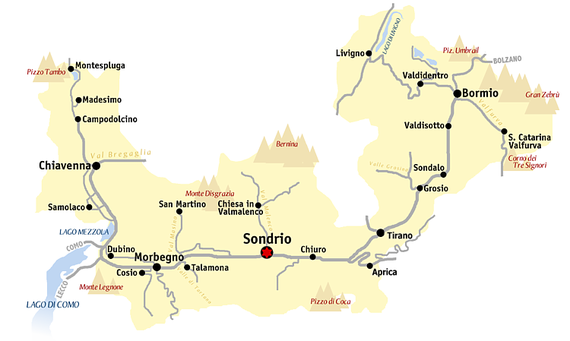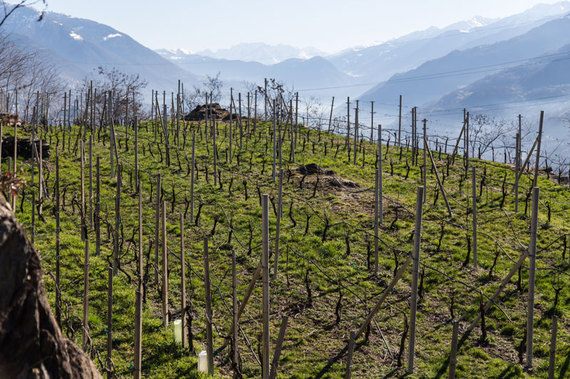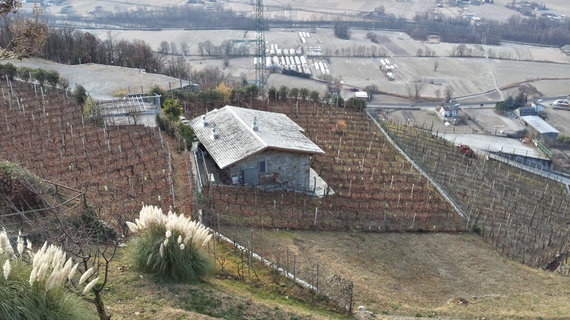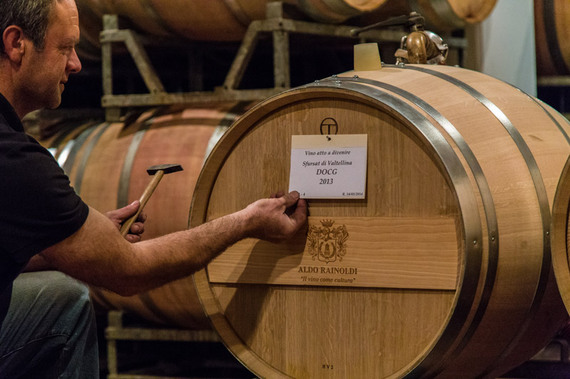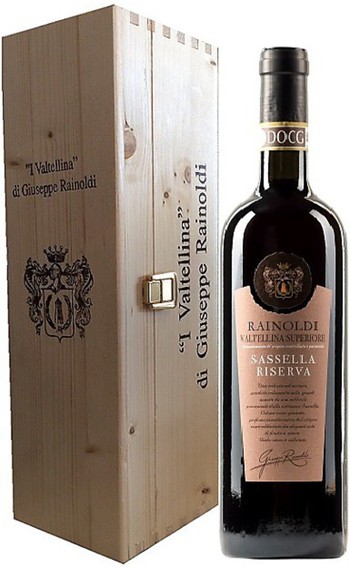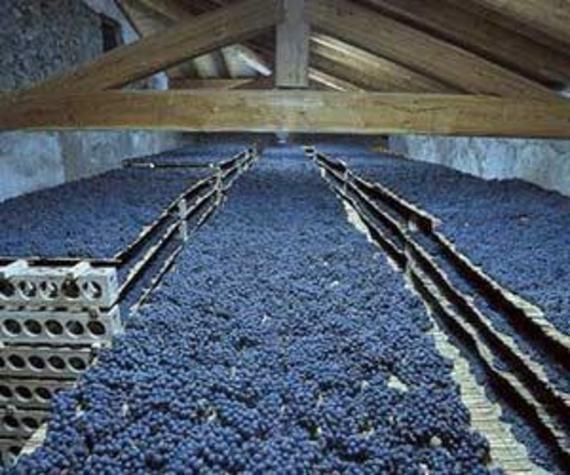The Nebbiolo grape variety has long been associated with Italy's Piedmont region. There it is used to produce two of Italy's greatest wines, Barolo, the long heralded king of Italian wines, and its equally distinguished cousin Barbaresco. Nebbiolo has established small, far flung outposts in such diverse locations as Australia, Argentina and California. There is one other kingdom, however, where it reigns supreme. This region, largely unknown to international wine enthusiasts, is Lombardy's hidden valley: the Valtellina.
The Valtellina is a long narrow alpine valley on the Rhaetian side of the Alps in the province of Sondrio at the far north of the Lombardy region along the Swiss-Italian border. The valley, about 60 miles northeast of Milan, runs along a 132 mile east-west axis from the village of Berbenno to the village of Tirano. The valley was carved out by the Adda River out of the hard granite of the local mountains.
The wine producing region however is only about 30 miles in length, 15 miles on either side, roughly, of the town of Sondrio along the right bank of the river. Tiny vineyard plots, averaging only .65 acre in size, are spread out along the south facing slopes of the mountains at altitudes of 750 feet to 2,500 feet above sea level. The total area under cultivation is slightly more than 2,100 acres
This is one of the most dramatic vineyard landscapes in the world, invoking comparisons with the unlikely terraced vineyard plots of Germany's Mosel, Portugal's Douro, and Italy's Alto Adige. If they were connected end to end the stone retaining walls of the terraces, called muretti, (little walls), would form a continuous wall 1,500 miles long. This is the largest terraced wine region in Italy. It has been nominated to be a UNESCO world heritage site. Only grapes planted on the south facing terraces, preferably with a western aspect, have any chance of ripening here.
The soils in the valley are sandy and gravelly, well drained, alluvial soils rich in silica. Large stones on the surface absorb heat during the day, much like the galets of the Rhone's Chateauneuf du Pape region, releasing it at night. Much of the sand and gravel soils in the terraces was hauled up the back breaking slopes in baskets from the valley bottom. The large diurnal variation in daily temperatures, typical of vineyards at altitude, promotes acidity while the heat retaining gravel soils helps promote ripening.
Warm dry summers with long days of sunshine help to maximize sugar levels in the grapes, creating an ideal mix of sugar, acidity and bright vibrant cherry scented fruit. The Rhaetian Alps on the north side of the valley block the cold northern winds while the Orobie Alps on the south side of the valley block winds from the south. The la breva, a warm gentle wind that originates over Lake Come moves warm air into the Valley and helps promote pollination in the spring and reduce fungal diseases.
Historically, the Valtellina has been vigorously fought over by Europe's political powers. The valley was conquered by the Carolingian Empire in the 8th century and became part of the Frankish kingdom. The region hosts the Alpine passes that connect Lombardy and the plains of Italy's Po River with the Danube River watershed, a key trade route between northern Italy and central Europe. During the Thirty Year's War, Catholics and Protestants engaged in a genocidal religious cleansing of the valley. The Catholics won.
During the Second World War the Valtellina's remote location led Italian fascist dictator Benito Mussolini to consider the valley for his last stand. Mussolini was convinced that with 50,000 of his Blackshirt supporters, he could hold out indefinitely in the Valtellina. He was in fact captured by Italian partisans in the town of Dongo on the northwestern shore of Lake Como; only a few miles from the Valtellina.
The tiny vineyards of the Valtellina
Wine production in the Valtellina dates back more than two millennium, to the Etruscans and Ligurians, and predates Roman times. The Nebbiolo grape was first introduced into the Valtellina in the early Middle Ages. Its introduction was most likely the result of Benedictine Monks moving into the valley in the 12 century.
The Nebbiolo grown in the Valtellina, an ancient clone of the modern Nebbiolo grown in Piedmont, is called Chiavennasca. The name is an adaptation from the local dialect, Ciu Venasca, meaning "more winey". Over time Nebbiolo/Chiavennasca came to replace the other indigenous grape varieties and today it represents 90% of the grapes cultivated in the region. Other local grape varieties include Brugnola (a very remote clone of Nebbiolo), Rossola, and Pignola.
The Rosso di Valtellina DOC (Denominazione di Origine Controllatra) is the foundation of the quality pyramid in the Valtellina. This wine can be produced throughout the valley of the Adda. The Valtellina Superiore is designated a DOCG (Denominazione di Origine Controllatra e Garantita), Italy's highest ranking for wines of superior quality.
"Superiore" wines are limited to a maximum yield of approximately 3.3 tons/acre. The wine must consist of at least 90% Chiavennasca/Nebbiolo produced from vineyards with a planting density of at least 1,600 plants per acre. The wine must be aged for a minimum of 24 months of which at least 12 months must be in wooden casks of any size. The alcohol level must be at least 12%. These wines can only be produced in specific sub-districts of the Valtellina.
The Valtellina Superiore DOCG is divided into 5 different sub-districts.
From west to east these sub-districts are Maroggia, Sassella, Grumello, Inferno and Valgella.
Maroggia is the smallest of the sub districts with only about 60 acres under cultivation. Only about 10,000 bottles are produced. The wines from Maroggia have an intense ruby red color featuring cherry, raspberry and blackberry aromas along with typical Nebbiolo aromas of rose petal and violet. Maroggia wines tend to be balanced, full, and dry, with soft light tannins and good acidity. These wines have a long and elegant finish.
Recommendations
Cantina Sesterzio, Maroggia Valtellina Superiore, DOCG Italy ($20)
Cooperativa del Vino, Maroggia Valtellina Superiore, DOCG Italy ($19)
Sassella is the most prestigious of the Valtellina's wine districts. It covers an area of approximately 325 acres. It produces around 600,000 bottles a year. The vineyards are located at the foot of a large, steep slope that bulges out of the Valley wall. These vineyards have excellent drainage and a particularly sunny southerly aspect. The gravelly soils contain large stones, sassi in Italian, which gave the sub-region its name. Sassella wines have a bright ruby color featuring aromas of cherry and raspberry jams, roses and ripe black cherry. On the palate the wine is full, with smooth soft tannins, complex, nuanced flavors and an elegant finish with notes of prune and spices.
A typical vineyard in the Valtellina
Recommendations
Aldo Rainoldi, Sassella Riserva, Valtellina Superiore DOCG, Italy ($25)
Ar.Pe.Pe, Stella Retica Riserva, Sassella Valtellina Superiore, DOCG, Italy ($35)
Grumello is a 200 acre district northeast of the city of Sondrio, It takes its name from the Grumello castle which has towered over the valley since the 13th century. Annual production is around 300,000 bottles. The vineyards rise to an altitude of 2,200 feet above sea level, 1,200 feet above the valley floor and are among the highest in the Valtellina. Grumello wines are a light, elegant, ruby color and exhibit many of the typical Nebbiolo aromas of potpourri, spice, tar and leather. These are medium to light bodied wines, with smooth light tannins, crisp medium acidity underscoring tart juicy red fruit with hints of tobacco and even some minerality. Typically they are faster maturing than those of neighboring Sassella.
Recommendations
Aldo Rainoldi, Grumello, Valtellina Superiore Grumello, DOCG, Italy ($18)
Nino Negri, Sassorosso Grumello, Valtellina Superiore, DOCG, Italy ($15)
Inferno, meaning hell in Italian, is a 140 acre sub-region. Annual production is around 350,000 bottles. The terrain here is particularly uneven and difficult to farm. Tiny terraces, some as little as 500 square feet stretch between the villages of Poggiridenti and Treviso. The slopes here are also believed to retain more heat than other parts of the valley and may be the origins of the name inferno. These wines tend to be a dark garnet in color and show riper fruit with pronounced notes of dried red and black fruit and flowers aromas with hints of spice and tobacco. Like other Valtellina wines it has a medium body with bright crisp acidity and fine smooth tannins.
Recommendations
Aldo Rainoldi, Inferno Riserva, Valtellina Superior, DOCG, Italy ($33)
Nino Negri, Inferno, Valtellina Superiore, DOCG, Italy ($22)
The easternmost district in the Valtellina is Valgella, about 10 miles east of Sondrio. Stretching from the villages of Chiuro to Teglio, the sub-region covers over 340 acres and is the largest of the sub-regions. Yearly [production is around 130,000 bottles. It sits in the Val Fontant valley, a side valley of the Valtellina, surrounding the tiny village of Valgella. These wines tend to be a bit more tannic while exhibiting the typical Nebbiolo aromas of cherry, roses and dried red and black fruit with hints of earth and tobacco. These are medium bodied wines with crisp acidity and sharp tart sour cherry and cranberry flavors.
Recommendations
Balgera, Valgella, Valtellina Superiore, DOCG, Italy ($30)
Sandro Fay Ca Morei, Valgella, Valtellina Superiore, DOCG, Italy ($27)
The Valtellina produces three other categories of wines on a region wide basis. These are the Rosso di Valtellina DOC, Terazze Retiche di Sondrio IGT and the region's most famous wine, Sforzato di Valtellina.
The Rosso di Valtellina is also a Nebbiolo based wine although local varieties are typically blended in up to a maximum of 10%. It is typically aged for 7 months and it cannot be released before the July after the harvest. It is a dry, light ruby colored red wine with a minimum alcohol content of 11%, although most wines are bottled at between 12.5% and 13%. The total vineyard area devoted to the production of Rosso di Valtellina is around 540 acres.
Recommendations
Aldo Rainoldi, Rosso di Valtellina, DOC, Italy ($15)
Ar.Pe.Pe, Rosso di Valtellina, DOC, Italy ($30)
The Terazze Retiche di Sondrio IGT is a catch all designation that allows for the production of Sparkling, (yes they make sparkling Nebbiolo in the Valtellina) as well as sweet rasinated desert wines and late vintage wines. They also make rose and white wines in the Valtellina, including white wines made from Nebbiolo.
The Valtellina's most famous wine however is the Sforzato di Valtellina, also written as Sfursat. This is the first rasinated Italian dry red wine to obtain a DOCG classification. Obtained in 2003, it preceded Italy's more famous rasinated dry red wine, Amarone by 7 years.
The practice of rasinating red wines for several months before vinifying them is an ancient practice that dates back to classical antiquity. These wines have traditionally been referred to in Northern Italy as vini di paglia, wines of straw; a reference to the practice of drying the grapes for several months on mats of straw. The drying or "rasinating" would concentrate the sugars and acids in the grape allowing for the production of a more robust and concentrated wine. In ancient wines such wines were prized both for their concentration of flavor and for their superior holding ability.
The Sforzato di Valtellina is made from a selection of the finest Nebbiolo grapes. These are usually picked about a week or so earlier than the main crop. Immediately after harvesting they are placed on wooded lattices to dry in a climate controlled room called a fruttaio. Increasingly, the practice is to use plastic trays as they are more hygienic.
The grapes are typically left to dry for a period of 2 to 2.5 months, depending on the particular practice of the producer. During this period the grapes will lose about 40% of their volume concentrating the juice and the acids and sugars it contains. The rasinating process also modifies the acidity and enhances the aromatic characteristics of the wine. The grapes cannot be pressed until at least the 10th of December
After vinification, the wine is aged for 20 months first in wood for a minimum of 12 months and then in bottle before being released. Wood casks can vary from 5,000 liter botti to 225 liter French barriques. Historically, the practice was to use large wooden containers made of the local chestnut or Slavonian oak.
This practice is being replaced by the more innovative producers with smaller, traditional 225 liter barrels made from French or Slavonian oak. Chestnut imparts more tannins to maturing wine while smaller oak barrels produce smoother, finer, less tannic wines. The result is a strong red wine that is at least 90% Nebbiolo and with a minimum alcohol level of 14%. Approximately 275,000 bottles are produced yearly.
The combination of the Nebbiolo grape and the process of rasinating it for several months would suggest that the resulting wine would be a big, powerful concentrated red wine, something of a cross between Piedmont's Barolo's and the Veneto's Amarone. The result is in fact surprising.
While Sforzati wines exhibit more concentration than their Valtellina brethren, they still show the lightness and elegance; the crisp bright acidity and pronounced, tart, black and red fruit flavors typical of the Valtellina wines. The thin skin of the Nebbiolo grape, unlike the varieties used to make Amarone, and the practice of minimizing the amount of tannin extracted during vinification, unlike the traditional style of vinifying Barolo, creates a Nebbiolo wine unlike any other. This is a Nebbiolo truly in a class by itself.
Recommendations
Nino Negri, Sfursat 5 Stelle, Sforzato di Valtellina, DOCG, Italy ($75)
Aldo Rainoldi Sfursat, Sforzato di Valtellina, DOCG, Italy ($35)
There are approximately 40 wine producers in the Valtellina. Among the top wineries to look out for are: Nino Negri, the largest of the Valtellina producers and Aldo Rainoldi, one of the most innovative wine producers in the valley, Also worth looking for are Ar.Pe.Pe, Conti Sertoli Salis, Sandro Fay and Triacca.
For die hard aficionados of Nebbiolo, the Valtellina offers an alternative version of Nebbiolo, one completely different than the traditional styles of Piedmont's Barolo or Barbaresco wines. This is Nebbiolo like you have never seen it before, a light to medium fruity wine redolent with a bouquet of sour cherry and floral aromas, with crisp bright acidity and smooth delicate tannins.
I am indebted to Aldo Rainoldi for his generous help and advice and to my friends Paolo and Christina Nava for introducing me to the wines of the Valtellina.


